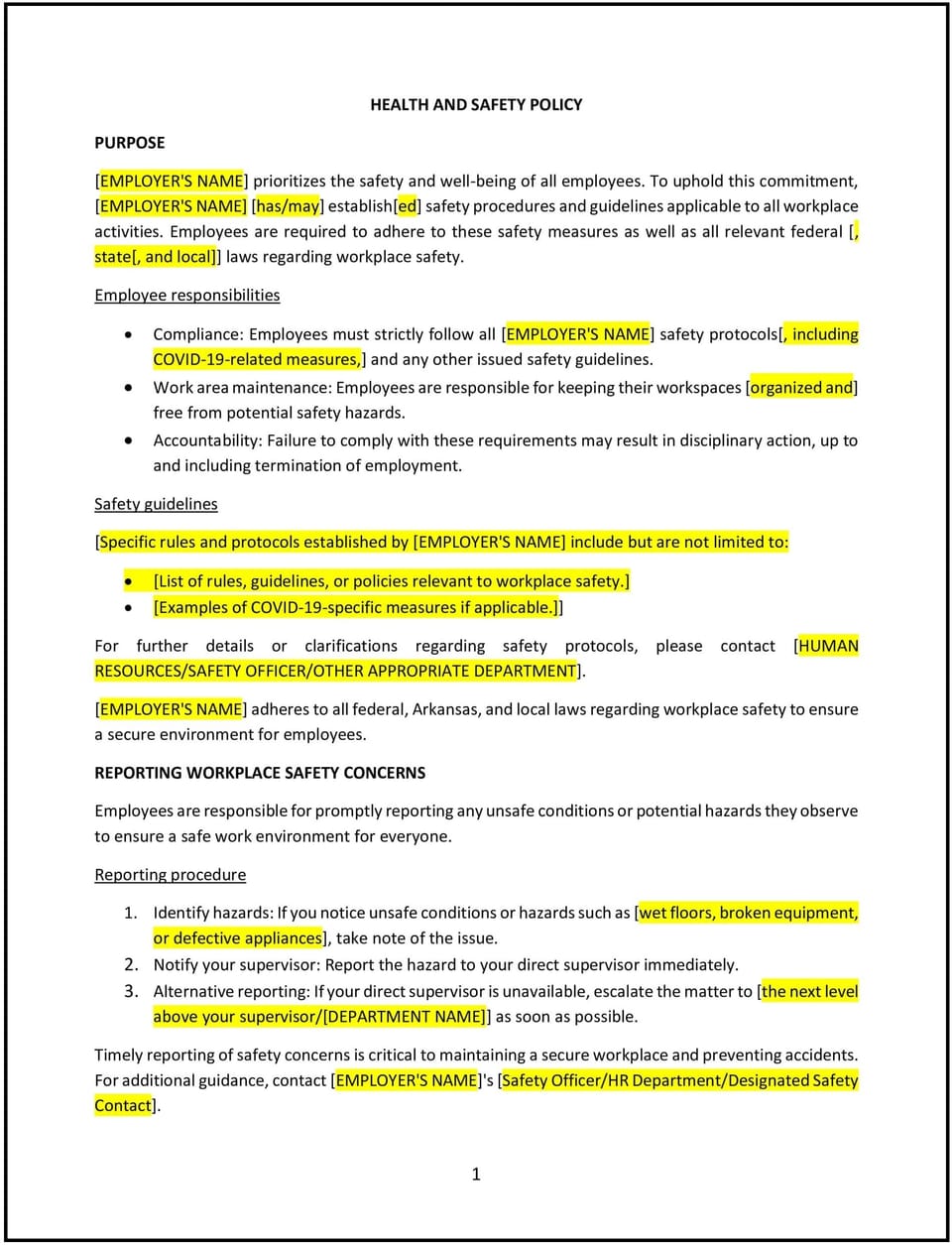Health and safety policy (Arkansas): Free template

Health and safety policy (Arkansas)
In Arkansas, a health and safety policy provides businesses with a framework to ensure the well-being of employees and visitors while maintaining compliance with workplace safety regulations. This policy outlines responsibilities, preventive measures, and response procedures to create a secure work environment.
This policy specifies the business’s commitment to health and safety, the roles of employees and management, and protocols for addressing hazards or emergencies. By implementing this policy, Arkansas businesses can reduce workplace risks, improve employee morale, and ensure compliance with safety laws.
How to use this health and safety policy (Arkansas)
- Define safety standards: Clearly outline the business’s health and safety expectations, including adherence to state and federal regulations.
- Identify responsibilities: Assign specific roles to employees and management for maintaining safety measures, such as conducting inspections or reporting hazards.
- Establish preventive measures: Include procedures for identifying and mitigating risks, such as training programs, equipment maintenance, and hazard assessments.
- Communicate emergency protocols: Provide clear instructions for responding to workplace incidents, such as evacuations, first aid, or contacting emergency services.
- Monitor and update: Regularly review the policy to ensure it reflects changes in workplace conditions, laws, or safety practices.
Benefits of using this health and safety policy (Arkansas)
This policy offers several advantages for Arkansas businesses:
- Enhances workplace safety: Reduces the likelihood of accidents or injuries by promoting proactive safety practices.
- Improves employee well-being: Demonstrates the business’s commitment to protecting employees’ health and safety, fostering trust and morale.
- Supports compliance: Aligns with Arkansas safety laws and Occupational Safety and Health Administration (OSHA) regulations, minimizing legal risks.
- Reduces costs: Prevents costly incidents by mitigating risks and avoiding penalties for non-compliance.
- Boosts productivity: Maintains a safe and secure environment that enables employees to focus on their tasks effectively.
Tips for using this health and safety policy (Arkansas)
- Address Arkansas-specific considerations: Ensure the policy includes state-specific safety requirements or industry standards relevant to the business.
- Train employees: Provide regular training on workplace safety practices, emergency response procedures, and hazard identification.
- Conduct inspections: Schedule routine safety audits to identify and address potential risks before they escalate.
- Encourage reporting: Create a culture where employees feel comfortable reporting hazards or safety concerns without fear of retaliation.
- Review regularly: Update the policy as needed to reflect changes in laws, technology, or workplace conditions.
Q: How does this policy benefit the business?
A: This policy enhances workplace safety, reduces legal risks, and supports compliance with Arkansas and federal safety regulations, creating a secure environment for employees and visitors.
Q: What are the business’s responsibilities under this policy?
A: The business is responsible for implementing safety measures, providing training, conducting inspections, and responding to hazards or incidents promptly.
Q: How does this policy support compliance with Arkansas laws?
A: The policy aligns with Arkansas-specific safety regulations and OSHA standards, ensuring the business meets its legal obligations and avoids penalties.
Q: What steps should employees take to support workplace safety?
A: Employees should follow safety procedures, report hazards, participate in training, and use provided safety equipment as instructed.
Q: How can the business handle safety violations?
A: The business should address violations promptly by investigating, providing corrective training, and, if necessary, applying disciplinary measures to ensure compliance.
This article contains general legal information and does not contain legal advice. Cobrief is not a law firm or a substitute for an attorney or law firm. The law is complex and changes often. For legal advice, please ask a lawyer.


